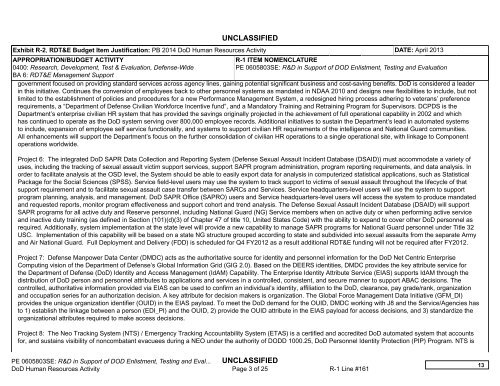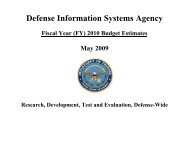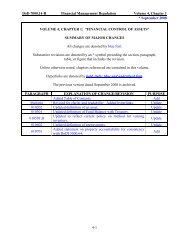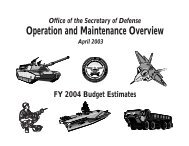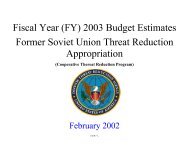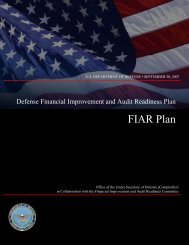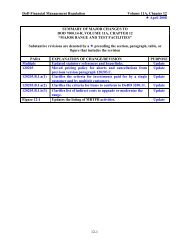Defense Human Resources Activity - Office of the Under Secretary of ...
Defense Human Resources Activity - Office of the Under Secretary of ...
Defense Human Resources Activity - Office of the Under Secretary of ...
Create successful ePaper yourself
Turn your PDF publications into a flip-book with our unique Google optimized e-Paper software.
UNCLASSIFIED<br />
Exhibit R-2, RDT&E Budget Item Justification: PB 2014 DoD <strong>Human</strong> <strong>Resources</strong> <strong>Activity</strong> DATE: April 2013<br />
APPROPRIATION/BUDGET ACTIVITY<br />
0400: Research, Development, Test & Evaluation, <strong>Defense</strong>-Wide<br />
BA 6: RDT&E Management Support<br />
R-1 ITEM NOMENCLATURE<br />
PE 0605803SE: R&D in Support <strong>of</strong> DOD Enlistment, Testing and Evaluation<br />
government focused on providing standard services across agency lines, gaining potential significant business and cost-saving benefits. DoD is considered a leader<br />
in this initiative. Continues <strong>the</strong> conversion <strong>of</strong> employees back to o<strong>the</strong>r personnel systems as mandated in NDAA 2010 and designs new flexibilities to include, but not<br />
limited to <strong>the</strong> establishment <strong>of</strong> policies and procedures for a new Performance Management System, a redesigned hiring process adhering to veterans’ preference<br />
requirements, a “Department <strong>of</strong> <strong>Defense</strong> Civilian Workforce Incentive fund”, and a Mandatory Training and Retraining Program for Supervisors. DCPDS is <strong>the</strong><br />
Department’s enterprise civilian HR system that has provided <strong>the</strong> savings originally projected in <strong>the</strong> achievement <strong>of</strong> full operational capability in 2002 and which<br />
has continued to operate as <strong>the</strong> DoD system serving over 800,000 employee records. Additional initiatives to sustain <strong>the</strong> Department’s lead in automated systems<br />
to include, expansion <strong>of</strong> employee self service functionality, and systems to support civilian HR requirements <strong>of</strong> <strong>the</strong> intelligence and National Guard communities.<br />
All enhancements will support <strong>the</strong> Department’s focus on <strong>the</strong> fur<strong>the</strong>r consolidation <strong>of</strong> civilian HR operations to a single operational site, with linkage to Component<br />
operations worldwide.<br />
Project 6: The integrated DoD SAPR Data Collection and Reporting System (<strong>Defense</strong> Sexual Assault Incident Database (DSAID)) must accommodate a variety <strong>of</strong><br />
uses, including <strong>the</strong> tracking <strong>of</strong> sexual assault victim support services, support SAPR program administration, program reporting requirements, and data analysis. In<br />
order to facilitate analysis at <strong>the</strong> OSD level, <strong>the</strong> System should be able to easily export data for analysis in computerized statistical applications, such as Statistical<br />
Package for <strong>the</strong> Social Sciences (SPSS). Service field-level users may use <strong>the</strong> system to track support to victims <strong>of</strong> sexual assault throughout <strong>the</strong> lifecycle <strong>of</strong> that<br />
support requirement and to facilitate sexual assault case transfer between SARCs and Services. Service headquarters-level users will use <strong>the</strong> system to support<br />
program planning, analysis, and management. DoD SAPR <strong>Office</strong> (SAPRO) users and Service headquarters-level users will access <strong>the</strong> system to produce mandated<br />
and requested reports, monitor program effectiveness and support cohort and trend analysis. The <strong>Defense</strong> Sexual Assault Incident Database (DSAID) will support<br />
SAPR programs for all active duty and Reserve personnel, including National Guard (NG) Service members when on active duty or when performing active service<br />
and inactive duty training (as defined in Section (101)(d)(3) <strong>of</strong> Chapter 47 <strong>of</strong> title 10, United States Code) with <strong>the</strong> ability to expand to cover o<strong>the</strong>r DoD personnel as<br />
required. Additionally, system implementation at <strong>the</strong> state level will provide a new capability to manage SAPR programs for National Guard personnel under Title 32<br />
USC. Implementation <strong>of</strong> this capability will be based on a state NG structure grouped according to state and subdivided into sexual assaults from <strong>the</strong> separate Army<br />
and Air National Guard. Full Deployment and Delivery (FDD) is scheduled for Q4 FY2012 as a result additional RDT&E funding will not be required after FY2012.<br />
Project 7: <strong>Defense</strong> Manpower Data Center (DMDC) acts as <strong>the</strong> authoritative source for identity and personnel information for <strong>the</strong> DoD Net Centric Enterprise<br />
Computing vision <strong>of</strong> <strong>the</strong> Department <strong>of</strong> <strong>Defense</strong>’s Global Information Grid (GIG 2.0). Based on <strong>the</strong> DEERS identities, DMDC provides <strong>the</strong> key attribute service for<br />
<strong>the</strong> Department <strong>of</strong> <strong>Defense</strong> (DoD) Identity and Access Management (IdAM) Capability. The Enterprise Identity Attribute Service (EIAS) supports IdAM through <strong>the</strong><br />
distribution <strong>of</strong> DoD person and personnel attributes to applications and services in a controlled, consistent, and secure manner to support ABAC decisions. The<br />
controlled, authoritative information provided via EIAS can be used to confirm an individual’s identity, affiliation to <strong>the</strong> DoD, clearance, pay grade/rank, organization<br />
and occupation series for an authorization decision. A key attribute for decision makers is organization. The Global Force Management Data Initiative (GFM_DI)<br />
provides <strong>the</strong> unique organization identifier (OUID) in <strong>the</strong> EIAS payload. To meet <strong>the</strong> DoD demand for <strong>the</strong> OUID, DMDC working with J8 and <strong>the</strong> Service/Agencies has<br />
to 1) establish <strong>the</strong> linkage between a person (EDI_PI) and <strong>the</strong> OUID, 2) provide <strong>the</strong> OUID attribute in <strong>the</strong> EIAS payload for access decisions, and 3) standardize <strong>the</strong><br />
organizational attributes required to make access decisions.<br />
Project 8: The Neo Tracking System (NTS) / Emergency Tracking Accountability System (ETAS) is a certified and accredited DoD automated system that accounts<br />
for, and sustains visibility <strong>of</strong> noncombatant evacuees during a NEO under <strong>the</strong> authority <strong>of</strong> DODD 1000.25, DoD Personnel Identity Protection (PIP) Program. NTS is<br />
PE 0605803SE: R&D in Support <strong>of</strong> DOD Enlistment, Testing and Eval... UNCLASSIFIED<br />
DoD <strong>Human</strong> <strong>Resources</strong> <strong>Activity</strong> Page 3 <strong>of</strong> 25 R-1 Line #161<br />
13


